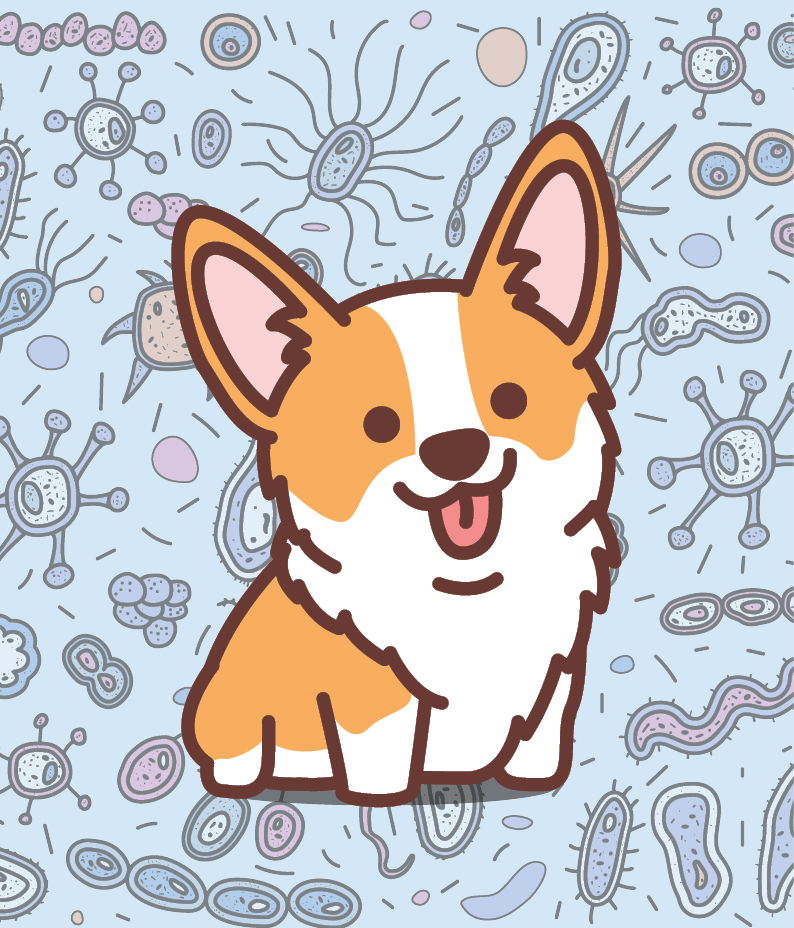TRENDS IN YOUR INBOX: Biosecurity in the Spotlight
In the Clear: Biosecurity in the Spotlight

“It was very scary to realize the reality of asymptomatic carriers and to acknowledge the veterinary clinic as a real source of potential infection.”
—RACHEL BLANKMEYER, BLACK CANYON VETERINARY CLINIC
by Constance Hardesty, MSc
We had an outbreak of Mycoplasma in our small town’s canine population, and several dogs (very old, very young, or immunocompromised) developed fatal mycoplasma pneumonia.
Hundreds of others were symptomatic, and many were identified as asymptomatic carriers.
Mycoplasma cynos is typically a secondary pathogen, so we worked with the vaccine company and IDEXX to further investigate and to definitively identify the pathogen. We were able to inform the public and educate regarding symptoms, risks, and preventive measures.
It was very scary to realize the reality of asymptomatic carriers and to acknowledge the veterinary clinic as a real source of potential infection—not to mention the ever-lurking threat that pathogens are constantly changing and evolving, and bugs that were once thought to be “not so scary” can now cause acute death in less than 24 hours.
—Rachel Blankmeyer, owner of Black Canyon Veterinary Clinic, Montrose, Colorado
Many nosocomial or hospital-acquired infections (HAIs) go unnoticed, according to the 2018 AAHA Infection Control, Prevention, and Biosecurity (ICPB) Guidelines.
That means “solely relying upon the awareness of outbreaks as a measure of effective ICPB practices results in a false sense of security and unnecessary patient and staff health risks,” the guidelines warned.
Jason Stull, VMD, MPVM, PhD, DACVPM, is an assistant professor at both The Ohio State University’s College of Veterinary Medicine and the Atlantic Veterinary College at the University of Prince Edward Island. He chaired the ICPB task force, which wrote the ICPB guidelines.
Hospital-acquired infection is “very much a silent problem of unknown dimensions,” Stull pointed out.

Jason Stull, VMD, MPVM, PhD, DACVPM
“With no national requirement or mechanism for reporting veterinary HAIs, incidence data [are] limited to a handful of research projects and published outbreaks. Although that evidence is too sketchy to draw general conclusions, it is clear that HAIs occur in veterinary medicine and are very much a concern for every veterinary practice. Also, it highlights that new infectious diseases are right at our ‘back door,’ as has been consistently pointed out by outbreaks related [to] animal importation,” he explained.
Canine influenza A (H3N2), introduced to the United States in 2015, is one recent import.
“Recent evidence suggests this virus has been introduced in Canada and the United States multiple times through importation of infected dogs from Asia,” Stull said.
Once introduced, outbreaks follow.
“Animal movement between cities and states, but also internationally, is perhaps one of our greatest infectious disease vulnerabilities,” Stull said.
“Diseases that are currently uncommon or do not exist in North America, but are common elsewhere, can quickly take hold with importation,” he added.
“This is an area veterinary staff need to keep on their radar,” Stull advised. All intake interviews and medical histories should include detailed questions about recent travel.
To tackle the problem at its source, he added, veterinarians could lead the effort to regulate animal importation.
Learn More
Basic Info
AAHA. 2018 AAHA Infection Control, Prevention, and Biosecurity Guidelines. 2018.
AAHA. Keep It Clean: Infection Control and Biosecurity in Veterinary Medicine by the Numbers.
AAHA. “AAHA Traditional Standards.” AAHA Standards of Accreditation. Login required.
Veterinary Infection Control Committee, National Association of State Public Health Veterinarians. “Compendium of veterinary standard precautions for zoonotic disease prevention in veterinary personnel.” JAVMA, 247:11 (December 1, 2015), 1252–1277 and JAVMA 248:2 (January 15, 2016), 171.
The American Veterinary Medical Association (AVMA) has made a start. In the past year, it successfully lobbied for stronger biosecurity regulations in commercial agriculture. Stull would like to see a similar effort for pets.
“Ideally, we [veterinarians] will work together now to create and guide voluntary quarantine processes for companion animals coming from out of the country to help protect us,” Stull hoped.
“Meanwhile, biosecurity is the frontline defense to [prevent] these emerging diseases from reaching the patients under our care and exploding in the surrounding pet community,” he added.
AAHA’s biosecurity guidelines were published in November 2018. But the AAHA Standards of Accreditation have covered infection control and prevention for decades.
So, how do the guidelines and standards differ?
Standards set out the requirements for accreditation. Guidelines provide a roadmap and practical advice. In other words, standards tell you what, guidelines tell you how.
AAHA mandatory standards for infection control require practice team members to follow policies related to personal hygiene, patient care, and disinfection of equipment and facilities. That includes frequent handwashing or the use of antimicrobial agents on hands and hospital surfaces.
Biosecurity Bouncers Prevent Infection Invasion
AAHA practices said they struggle with identifying infectious patients before they enter the practice.
The AAHA ICBP Guidelines’ answer is triage when clients book appointments. The guidelines suggest the following:
Find out about the pet’s vaccination history and about specific symptoms, including coughing, sneezing, and acute vomiting or diarrhea. Ask the following questions:
- Has the pet has been to a boarding kennel, dog park, daycare facility, animal shelter, or other similar venue in the past month?
- Has the pet traveled to or from another area or country?
- Are other pets in the household ill?
Your appointment-setting app may be modified to ask those questions and then direct clients to call for an appointment if they answered yes to any of them. Check with your webmaster or software vendor to learn what’s possible.
Or, if you book appointments by phone, train customer service representatives to ask the questions and take appropriate action.
When you know ahead of time what you’re dealing with, you can take precautions to keep the animal isolated from other patients.
For a full list of questions to ask and some recommended precautions, see the ICPB guidelines, Table 5.
Protect Your Person
Gloves, mask, gown or lab coat, foot covers or booties, and eye protection.
Several practices told Trends that they do not fully implement policies requiring personal protective equipment (PPE).
Some staff may find the equipment bulky or inconvenient, or the appointment schedule may not give staff enough time to put on, take off, contain, and dispose of PPE.
Nevertheless, PPE matters. The ICBP guidelines have this to say:
“PPE places a barrier between staff and an exposure risk (e.g., infected animal, diagnostic specimens) and, with appropriate use, helps prevent the spread of pathogens between animals and within the practice. [It is] critical for effective infection control and should be used when indicated.”
The guidelines discuss PPE in some detail, and Table 1 and Table 4 offer some key information to include in your PPE protocol.
Besides that, the mandatory standards require that materials that may be contaminated should be placed in impervious containers or bags before they are transported within the practice, for example, from isolation to the laundry room.
The guidelines are more comprehensive and build on what your practice already has in place. They walk you through organizing and implementing a full-on biosecurity program. You’ll find them full of ideas, advice, and templates for policies, protocols, checklists, how-to instructions, and leadership tips.
Whatever your approach to infection control, using the guidelines will systematize and strengthen your existing protocols and enlist the whole practice team in the effort.
The guidelines recommend actions ranging from the most critical to the least critical.
“These guidelines were created to help practitioners identify areas for improvement as well as recognize things they may already be doing well,” said Glenda Dvorak, DVM, MPH, MS, DACVPM. She is assistant director for the Center for Food Security and Public Health at the Iowa State University College of Veterinary Medicine and was a member of the AAHA ICBP task force.
Stull agreed: “We have approached this area from the perspective of the busy veterinary team member, often with little background in infection control, and distilled the key practices with greatest potential for success into a succinct ‘how-to manual.’”
“With these guidelines, every practice can have an infection-control program of which they can be proud and that will protect patient, owner, and personnel health,” Stull added.
To learn more about how infection control works in the real world, Trends asked several accredited members about their experiences.
Seven practices shared their challenges and rated their own performance. Such a small group can’t be taken as representative of AAHA practices. Instead, it offers real-world examples you won’t find anywhere else. Whether you’ve had an outbreak in your own practice or you’re aiming for the next level in biosecurity, you’ll see you’re not alone.
Most of the practices in this group struggle on several fronts, from identifying infectious animals before they enter the practice to ensuring that staff wear personal protective equipment. Other challenges include creating and updating policies and protocols and enforcing requirements for cleaning and disinfection.
The guidelines offer straightforward, how-to recommendations for addressing all of those challenges. Read on for solutions to management issues, and see the sidebar on the next page for advice on specific problems.
At its core, infection control and prevention is a management issue. Two management tools for improving overall performance are written policies and accountability. The ICPB guidelines recommend both.
“Every veterinary practice should have a documented ICPB program,” the guidelines emphasize. “Start where you are, by putting your current policies and standard operating procedures (SOPs) in writing.”
Need Ideas?
Start with the AAHA Standard Sample Protocol for Contagious Disease—Effective Containment (CD01). Combine that with the guidelines’ policy recommendations and the detailed SOPs, and you’re on track to a written protocol.

“We are dealing with a sneezing outbreak, and it has been a reminder about how important it is to maintain cleanliness at all times.”
—ANONYMOUS AAHA-ACCREDITED PRACTICE
Once the policies and SOPs become routine, the guidelines recommend you take your program to the next level. Collect all of the policies and protocols to make a biosecurity manual. Then start adding new sections on staff education and training, client education, surveillance, and compliance.
Making the manual, enforcing the rules—whose job is that?
In every practice that Trends consulted, owners and medical directors were primarily responsible for infection control and prevention. That makes sense in terms of liability, insurance, and influence.
But the guidelines suggest that, when it comes to planning and implementation, medical staff may take the lead.
“An effective approach, strongly recommended by the ICPB task force, is to appoint a practice ‘champion’ who takes primary responsibility for implementing ICPB protocols and ensuring staff compliance,” the guidelines state.
“This individual should focus on the two principal components of ICPB, which are to (1) limit pathogen introduction, exposure, transmission, and infection within the hospital population and (2) evaluate the effectiveness of infection control practices at controlling disease.”
Your best bet for this role is a veterinarian or technician who is interested and motivated, even if they don’t have special training in infection control. They can acquire the knowledge they need with self-study. In fact, when Trends asked, “How do you learn about biosecurity threats and prevention?” every person pointed to their own reading and research.
Your champion can put together their basic training by reading the AAHA guidelines, AAHA Standards of Accreditation, AAHA’s biosecurity booklet (Keep It Clean), and other resources developed for veterinary and human medicine. (See the “Learn More” textbox.)
With few regulations setting out how infection control can best be carried out, it’s up to the veterinary profession to establish and promote norms, Stull says. That applies equally to the United States and Canada.
By the Numbers
8,000+
Animals transported from Korean meat farms, natural disasters, and overpopulated shelters by the Humane Society since 2017.1
$8,940
Median cost to each of five practices affected by a canine influenza outbreak.2
24 hours
How long canine influenza virus can live in the environment.3
48 hours
How long canine influenza virus can live on
organic matter. 3
Clean it all up
“We found that we were very inadequately disinfecting between exams—shoes, clothing, face, jewelry, exam table, scales, chairs, doorknobs, and lids on garbage cans.”
—Natalie M. Marks, DVM, Blum Animal Hospital, Chicago3
Weak link
A review of infection control in veterinary hospitals found poor compliance among staff. Educational campaigns barely helped.4
Strong chain
Veterinary workplaces with infection control policies, management support, and a staff champion are more likely to have good infection control.4
Sources
- Humane Society of the United States.
- Mwacalimba, Kennedy and Annette Litster. 2018. “Pilot study of the financial and practice protocol impacts of canine influenza virus (H3N2) outbreaks in example veterinary practices.” Preventive Veterinary Medicine 151: 1–4.
- Marks, Natalie L. “March 2015: Chicago, Illinois—The Initial H3N2 Outbreak.” In Infectious Disease Handbook, available from Merck.
- Willemsen, A., et al. 2019. “Infection control practices employed within small animal veterinary practices—A systematic review.” Zoonoses Public Health 66: 439–57.
With a doctorate in pathobiology from the University of Guelph, and as a member of the faculty of veterinary colleges in the United States and Canada, Stull sees infection control in both countries.
“Although we all struggle with the same implementation issues and HAI concerns, I have noticed some differences between the two countries,” Stull notes.
“For instance,” he says, “during a recent outbreak of canine influenza in Canada, local veterinary clinics and groups (groomers, rescue organizations) worked together under the leadership of a researcher at the University of Guelph in Ontario to identify and enforce quarantine of infectious dogs and communicate risks to the public.
“Doing so, they were able to stop and contain the outbreak . . . something we have not been very successful at doing during similar experiences in the United States,” he observes.
“There are likely a number of reasons for these differences, but in part, the development of an infection-control veterinary community was important in making this happen,” he adds.
“It is up to each of us working in veterinary/animal health to work toward establishing this sense of community. It starts within our own practices and facilities and then grows from there.”
 |
Constance Hardesty, MSc, is a freelance writer and is the former editor-in-chief of AAHA. |
Photo credits: ©iStock.com/Syuzanna Guseynova, ©iStock.com/Chayapoll Tummakorn, ©iStock.com/HidamariNeko, ©iStock.com/Roi and Roi, ©iStock.com/HidamariNeko
NEWStat Legislation & regulation Advancements & research Trends magazine




